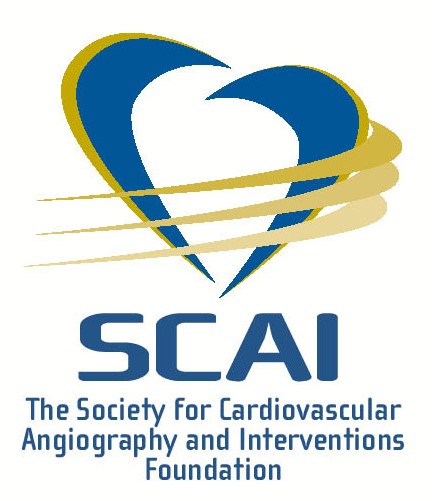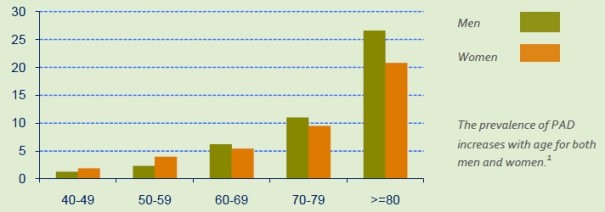
It is estimated that 8 million US patients have peripheral artery disease (PAD). Patients older than 60 represent 12-20% of this population. Overall, population awareness of PAD is estimated at 25%
Prevalence of PAD (%) by Age Group (years)

While the incidence of peripheral artery disease (PAD) is growing, there has been little expert guidance on the treatment and management of common forms of the disease. A series of expert consensus documents has been written by SCAI's Peripheral Vascular Disease (PVD) Committee and e-published this summer in Catheterization and Cardiovascular Interventions (CCI). "We are seeing an increase in PAD," states, Christopher White, MD, MSCAI, FACC, FAHA, FESC, ACE Secretary and Medical Director of the John Ochsner Heart & Vascular Institute at the Ochsner Clinical School in New Orleans, LA. According to Dr. White, catheterization laboratories should consider peripheral vascular services as essential elements of comprehensive care. "Our patients are symptomatic and they need to be helped,"
The series includes four expert consensus documents on common forms of PAD, including aorto-iliac, femoropopliteal, infrapopliteal and renal artery stenosis (RAS)."Those of us who commonly treat patients with PAD know it can have a significant impact on quality of life, including pain and risk of limb loss or organ damage," states PVD Committee Co-chair Bruce Gray. DO, FSCAI. Today we have safe and effective endovascular treatments to treat a greater number of patients who previously may have had few options. "These papers help interventional cardiologists better understand which patients will benefit from treatment and those for whom treatment may not be optimal."
Key Recommendations
In the first paper of the series, aorto-iliac PAD endovascular treatment, the expert panel found that patients have a success rate greater than 90% and a low mortality rate. According to the second paper in the series, revascularization with surgery or endovascular treatment is an option for those with severe infrapopliteal arterial disease, but not treating patients who are asymptomatic or mildly symptomatic. In the third paper, the expert panel noted balloon angioplasty continues to be a valid treatment option for patients with femoropopliteal disease, but it has suboptimal long-term results in some patients with areas of total occlusion or long stenoses, critical limb ischemia or diabetes. The fourth and final paper in the series discusses renal artery stenting (RAS) as an option for many patients who have historically been excluded from clinical trials, including those whose condition could not be managed with optimal medical therapy. RAS may be an option for patients with cardiac disturbance syndrome or flash pulmonary edema, patients with uncontrolled hypertension and those with significant stenoses whose blood pressure cannot be controlled with medication. "The series fills a void for expert guidance on PAD and renal artery management and is part of SCAI's ongoing commitment to help interventional cardiologists provide the best possible care for each patient's individual symptoms and condition," said Michael R. Jaff, DO, FSCAI, who chairs SCAI's PVD Committee. All four papers are available online at SCAI.org/Guidelines.
____________________
Source: Roger VL, et. al. Heart Disease and Stroke Statistics 2011 Update: A Report From the AHA Circulation 2011;123:e18-e209.